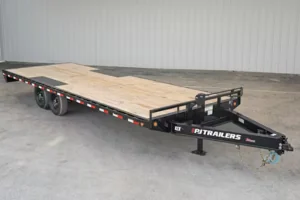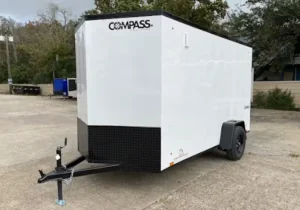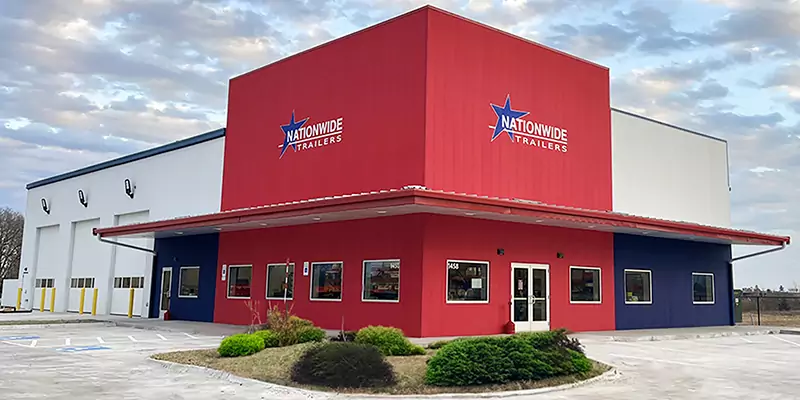Connecting a trailer to your vehicle is a simple way to haul more stuff. Of course, there is a wrong way and a right way to accomplish that. The process for hooking up a trailer varies based on the trailer you’re trying to connect. It’s pretty straightforward to connect a bumper pull trailer, which is a trailer that attaches to a hitch on your vehicle’s bumper. It is crucial to ensure you attach the trailer correctly. Learn how to hook up a trailer with this article.
What Is a Bumper Pull Trailer?
A bumper pull trailer hooks up to your tow vehicle via a ball hitch attached to the vehicle’s bumper. Bumper pull trailers provide many benefits, including:
- Affordability: Bumper pull trailers are more affordable than other types of trailers.
- Flexibility: You can tow a bumper pull trailer with several types of tow vehicles, like a pickup truck or an SUV, as long as they’re rated to haul the trailer’s weight.
- Easy turns: These trailers take the same path as your towing vehicle, so making turns can be more comfortable.
- Easy to tow: Bumper pull trailers are relatively lightweight, making them easier to tow. Additionally, they attach to the vehicle’s rear, which is more convenient.
- Versatility: You can haul various goods with bumper pull trailers, such as small recreational vehicles, landscaping or construction equipment and livestock.
- Classic: Bumper pull trailers have a sleek, classic design that’s more aesthetically pleasing than other trailers. They’re timeless yet modern.
7 Steps on How to Hook up a Trailer
It’s easy to attach a trailer to a car or other vehicle once you know how. Here are the seven steps for hooking up a trailer to a truck, SUV or other tow vehicle.
1. Enlist a Friend’s Help
The first step for hooking up a trailer to a truck or other tow vehicle is to find a friend to help. You can hook up your trailer by yourself if you rely on your mirrors, but it’s easier if you have a helper. Without a helper to guide you, you’ll likely have to get out of your trailer often to see how close your towing vehicle and trailer are. Before starting, you should agree on which hand signals to use for reversing and braking. Your friend should stand even with the trailer’s tongue on the driver’s side so you can see them clearly.
2. Move Your Trailer to an Accessible Area
It’s easier to attach your trailer to your vehicle if you line it up instead of trying to connect it from an angle. Choose a flat surface with plenty of space, like a driveway or parking lot. Some important things to remember are:
- Many trailers have a jack with a wheel that keeps the trailer level while it’s unattached to the towing vehicle. Keep the jack and wheel out when moving the trailer by hand to reduce the weight when lifting and moving it.
- If you can, load your trailer after you connect it. A loaded trailer is more challenging to move by hand. However, if your trailer is loaded, you can rotate it instead of trying to move it.
- Use the hand crank to raise your trailer’s hitch so it sits slightly higher than your vehicle’s ball hitch.
3. Line up Your Vehicle
Use your mirrors and your helper to maneuver your tow vehicle so it’s lined up with the trailer. Slowly reverse your vehicle and only slightly turn your wheel so you can keep it in line with your trailer. Keeping your vehicle and trailer lined up makes driving easier. Stop backing up when the ball hitch on your vehicle is close to the trailer’s tongue.
4. Position the Coupler Above the Hitch
Once the towing vehicle and trailer are aligned, turn the handle on the trailer jack — which is behind the coupler — to adjust the trailer coupler height so it’s higher than the hitch ball. You can use a regular jack to hold the trailer at the correct height if your trailer doesn’t have an attached jack. If the trailer is light and easy to move, you can lift the coupler and place it over the hitch ball. Otherwise, back your vehicle up slowly until the coupler is over the ball. Then, put the vehicle in park, engage the emergency brake and use the jack to lower the coupler onto the ball.
5. Secure the Trailer
Unlatch the trailer coupler by removing the latch pin or whatever is holding the latch in place and lifting the latch. Once the coupler is securely on the hitch, use the hand crank to lift the wheel and secure it to the trailer’s neck. Then, secure the trailer to the hitch with the latch. Use your jack to lift the trailer a little bit and test the connection. If the trailer disconnects from the ball, the coupler isn’t seated properly, so you need to unlatch it and shift the tongue forward or backward to seat it properly.
6. Attach the Chains
To tow your trailer legally, you must attach the safety chains. Connect these chains in a crisscross pattern to the bottom of your vehicle’s hitch. When the chains are properly secured, they won’t touch the ground. If the coupler disconnects from the hitch, the crisscross safety chains should catch it. These chains should meet or exceed your trailer’s gross weight. When everything is connected correctly, rotate the jack out of the way, then use a latch or pin to secure it, or you can detach the jack and store it in your vehicle.
7. Perform the Final Checks
Wrap the wiring harness around your trailer’s tongue to limit the excess wiring, then plug it in. The harness should have enough length to make turns without tension, but it shouldn’t touch the ground. After you plug in your lights, turn them on individually to ensure they work. You can have your helper call out the lights they’re seeing, or walk around your vehicle yourself. If you don’t have a helper, you can place a heavy object on your brakes to test the brake lights. Never drive a trailer if the electrical system is malfunctioning. Also, ensure your trailer has a license plate if your state or the states you’re traveling through require it. You’re can haul various goods once everything checks out.
Contact Nationwide Trailers
Now that you know how to hitch a trailer, it’s time to find a high-quality bumper pull trailer to meet your towing needs. Nationwide Trailers has a wide variety of trailers with custom design options, so you can find the trailer that’s right for you. Our staff will help you find what you’re looking for by taking the time to understand how you plan to use your trailer. Our customers always come first. When you trust us with your needs, we’ll do everything possible to ensure you leave satisfied. We’d love for you to visit one of our locations in Texas, Missouri, Arkansas and Oklahoma to see why Nationwide Trailers is the best. Contact us today to learn more.






